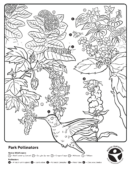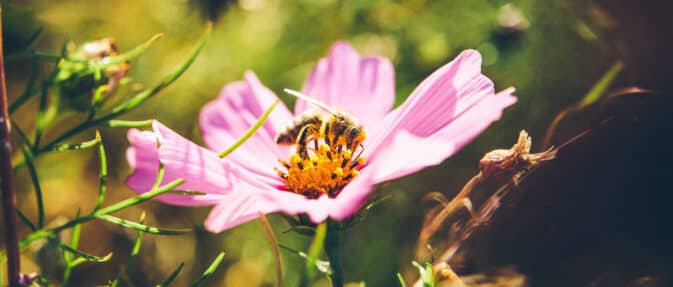
The Importance of Pollinators
Benefits of Pollinators
Pollinators are critical to our world, and are considered to be “keystone” species in the ecosystem. Here are just a few reasons why pollinators are so important:
- Pollinators assist with plant reproduction by helping to move pollen within or between flowers, playing a crucial role in biodiversity.
- Nearly 80% of all flowering plants need the assistance of pollinators to transfer pollen from flowers in order to produce seeds, fruits, and vegetables.
- Pollinators provide pollination services to over 180,000 different plant species and more than 1,200 crops. Approximately one out of every three bites of food you eat depends on the work of a pollinating animal.
- Pollinators support healthy ecosystems that clean the air, stabilize soils and support other wildlife.
How is NCPRD Supporting Pollinators?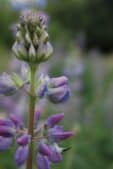
Parks, gardens, and greenspaces have become increasingly important to supporting the vitality of diverse pollinator species. One of the ways NCPRD is supporting local pollinators is by planting native flowering plant species in parks and natural areas. Native plants are best adapted to the climate and soil conditions of a specific region, often making them more drought tolerant and low-maintenance. These plants have evolved to develop a mutually beneficial relationship with local wildlife and pollinators, and are the heart of a pollinator-friendly garden.
NCPRD and Clackamas County participate in the Xerces Society’s Pollinator Habitat Kit Program, which provides plants and resources to help restore habitat and support declining pollinators.
NCPRD also removes invasive plants from parks and natural areas to enhance habitat and protect native plant species. Interested in helping out? Check for upcoming park stewardship events.
Visit a Pollinator Garden
Although there are pollinator-friendly plants throughout many NCPRD parks, there are dedicated pollinator gardens in the District, which NCPRD planted in coordination with Pollinator Partnership. Stop by to see a variety of blooming native flowers late spring through summer, and learn more about local pollinators from the interpretive signs at each park.
Alma Myra Park
7510 SE Thiessen Rd., Portland, OR 97267
Native flowers include osoberry, trillium, pacific bleeding heart, fringecup, western columbine and snowberry.
Hawthorne Park
7510 SE King Rd., Milwaukie, OR 97222
Native flower include goldenrod, yarrow, Oregon sunshine, meadow checkermallow, riverbank lupine and Douglas aster.
Stringfield Park
3614 SE Naef Rd., Milwaukie, OR 97267
Native flowers include camas, yarrow, Oregon sunshine, meadow checkermallow, riverbank lupine and Douglas aster.
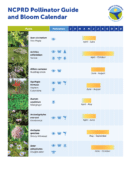 Pollinator Guide and Bloom Calendar
Pollinator Guide and Bloom Calendar
Interested in finding out when certain native flowers bloom in the parks? This Bloom Calendar shows the various native flower species that bloom throughout the year, providing nectar and pollen resources for our local pollinators. The Pollinator silhouettes indicate which pollinators predominantly visit these flowers.
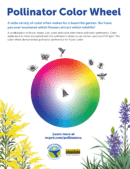
Pollinator Color Wheel
A wide variety of color often makes for a beautiful garden. But have you ever wondered which flowers attract certain wildlife? A combination of flower shape, size, scent, and color determines pollinator preference. Some pollinators require shallow flowers, while others have specially designed mouthparts to feed from flowers with deep nectar tubes or spurs. Color preference is often associated with the pollinator’s ability to see certain spectrums of UV light. This color wheel demonstrates pollinator preference for flower color.
Pollinator Coloring Sheet
Get out your crayons and colored pencils and brighten your day with a free printable coloring sheet that highlights different pollinators and their native plants.
Did you know?
Learn more about pollinators with these fun facts to share with your family and friends.
- There are almost 4,000 species of native ground and twig nesting bees in the U.S.
- The most familiar of non-native pollinators, the honey bee was imported from Europe almost 400 years ago.
- Bumble bees form small colonies, usually underground. They are generalists, feeding on a wide range of plant material from February to November and are very important, easy to distinguish pollinators. There are nearly 30 bumble bee species in the PNW.
- There are over 3,000 species of beetles found in the U.S. Beetles are known to pollinate plants such as Magnolia, sweetshrub, paw paws, and yellow pond lilies.
- Moths have an incredible sense of smell. Their sense of smell helps with communication and predatory avoidance as they pollinate nocturnally.
- The honey bee simply does not know how to pollinate tomato or eggplant flowers and it does very poorly compared to native bees when pollinating many native plants, such as pumpkins, cherries, blueberries, and cranberries. Often, specialist native bees are required for efficient pollination of these plant species.
- Hummingbirds are the primary pollinating birds in North America. Their long beaks and tongues draw nectar from flowers, which typically have tubular flowers, are odorless, and are red, orange, or yellow.
- Wet muddy areas can provide butterflies with both the moisture and minerals that they need to stay healthy. Some butterflies even eat rotting fruit. Not cleaning up all the messes in your garden can serve a purpose in providing for butterflies!
- There are many pollinating flies that are bee mimics. Bee-flies and syrphid flies can be differentiated by their huge eyes, very short antennae, and skinny legs when compared to bees.
How to Support Pollinators
- Plant native plants. Grow a haven for pollinators in your community garden, window sill, or backyard. Get inspired with a Native Garden Recipe Card for the Northwest, provided by Pollinator Partnership.
- Limit or eliminate use of pesticides. Many pesticides are extremely toxic to honey bees and other beneficial insects. Do not apply pesticides highly toxic to bees during bloom.
- Volunteer at NCPRD park stewardship events. NCPRD regularly hosts volunteer events to enhance parks, including cleaning up trash, removing invasive plants and planting native plants. Check for upcoming events.
